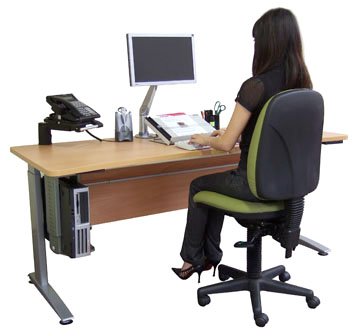Israeli scientists warn that sitting down for too long may give you a big bottom.
Not just eating junk food put your bottom at risk – sitting all day in the office is just as likely to broaden your rear.
The warning comes from a scientist who usually researches bed sores which can affect those bedridden or in a wheelchair due to paralysis.

Scans of their buttocks showed the muscles there shrinking and breaking down due to lack of exercise.
More surprising was the discovery that fat cells seemed to thrive on the inactivity, infiltrating the muscle, and creating thick “stripes” of fat.
Israeli researcher Professor Amit Gefen, whose findings are reported in the American Journal of Physiology – Cell Physiology, experimented on fat cells in a dish to test his conclusions.
Professor Amit Gefen spread a layer of fat cells on a piece of elastic and stretched the elastic, along with the cells.
The stretching was meant to mimic the constant pressure placed on the buttocks by being confined to a wheelchair or bed-ridden. A second layer of cells was fed exactly the same nutrients but not stretched.
After two weeks, the stretched cells contained noticeably more fat, and after four, the fat levels were 50 per cent higher. So the researcher’s advice to those sitting down on the job – Get up and go for a walk!
Researchers found that preadipocyte cells – the precursors to fat cells – turn into fat cells and produce even more fat when subject to prolonged periods of “mechanical stretching loads” – the kind of weight we put on our body tissues when we sit or lie down.
By studying MRI images of the muscle tissue of patients paralyzed by spinal cord injuries, they noticed that, over time, lines of fat cells were invading major muscles in the body.
This spurred an investigation into how mechanical load – the amount of force placed on a particular area occupied by cells – could be encouraging fat tissue to expand.
A team stimulated preadipocytes with glucose or insulin to turn them into fat cells. They then placed individual cells in a cell-stretching device, attaching them to a flexible, elastic substrate – or underlying – layer.
The test group of cells was stretched consistently for long periods of time, representing extended periods of sitting or lying down, while a control group of cells was not.
The researchers noted the development of liquid droplets in both the test and control groups. However, after just two weeks of stretching, the test group developed significantly more – and larger – droplets.
By the time the cells reached maturity, the group that received mechanical stretching had developed 50% more fat than the control group.
Professor Amit Gefen said: “Obesity is more than just an imbalance of calories. Cells themselves are also responsive to their mechanical environment. Fat cells produce more triglycerides [the major form of fat stored in the body], and at a faster rate, when exposed to static stretching.
“There are various ways that cells can sense mechanical loading. It appears that long periods of static mechanical loading and stretching, due to the weight of the body when sitting or lying, has an impact on increasing lipid [fat] production.”
These findings indicate that we need to take our cells’ mechanical environment into account as well as pay attention to calories consumed and burned, said Professor Amit Gefen.
Amit Gefen warned that, while there are extreme cases of people confined to wheelchairs or beds due to medical conditions, many people live a too sedentary lifestyle – spending most of the day behind a desk.
